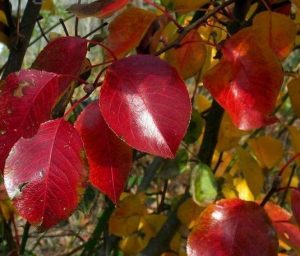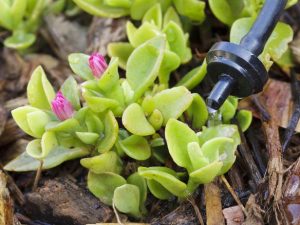 This has been an autumn of intense colors, but other than the fancy foliage the weather has felt more like summer than our typical fall. However, the season’s first light frost hit most of us this week, which means cold temps soon will be commonplace. As our weather progressively cools into November, it is important to water our yards, especially any newly planted additions.
This has been an autumn of intense colors, but other than the fancy foliage the weather has felt more like summer than our typical fall. However, the season’s first light frost hit most of us this week, which means cold temps soon will be commonplace. As our weather progressively cools into November, it is important to water our yards, especially any newly planted additions.
This week the time clocks for the irrigation systems of my personal gardens have been adjusted for cool-to-cold-weather watering. Yes, our winters are so mild that plants do need sporadic watering through winter. With that in mind there are two changes to irrigation functions that should be made in the first half of November: 1) Adjust irrigation to cycle on in the middle of the day, delivering the same amount of water as during summer, but 2) have it come on less often.
Set irrigation to come on after 10:00 in the morning and to be finished a couple of hours before sunset. This reduces the icicle affect that may form from very early morning watering, yet allows plants to soak up the water they need. Remember: the amount of water used never changes throughout the year. Water plants with the same volume of water as though we are still in the heat of summer. What we must do is to adjust the number of days between each cycle, and water in the middle of the day.
We often experience long dry spells during our winter that causes evergreens to dehydrate so severely that they can be damaged. During cold weather, now through the month of March, trees, shrubs, and vines should be watered twice a month. Remember: this winter watering method is critical to the “newbie’s” in our yards.
 Bottom-line, both of my irrigation clocks have been moved to come on at 10:00 in the morning every 9 days for now. By the end of November this will be adjusted to water every 14 days. This is a good program for homeowners that call Prescott their permanent home, and have a properly insulated irrigation system with valves below ground. If your system is shut down and drained for the winter, water by hand or with a hose.
Bottom-line, both of my irrigation clocks have been moved to come on at 10:00 in the morning every 9 days for now. By the end of November this will be adjusted to water every 14 days. This is a good program for homeowners that call Prescott their permanent home, and have a properly insulated irrigation system with valves below ground. If your system is shut down and drained for the winter, water by hand or with a hose.
My winter blooming flowers are watered about every 5 days for now, by the end of the month that will change to every 7 days. Lawns will keep their green through the end of the year with the same watering cycle. This is especially true for those of us who applied the ‘All Purpose Plant Food’ 7-4-4 over the lawn last month.
~~ ~~ ~~ ~~ ~~ ~~ ~~
As more and more leaves drop from deciduous plants, the evergreen shrubs in our yards become the anchors that hold together the scheme of each landscape. Here are several evergreen shrubs, including the Plant of the Week, that stand out through winter and enjoy being planted in fall . . .as long as they are watered a couple of times per month throughout the winter.
Oregon Grape Holly, Mahonia aquifolium, is a perfect mountain evergreen which is often mistaken for a holly. Solar yellow flowers cover the entire plant in spring followed by a summer berry, thus the name Oregon grape. The berries are very pretty and edible. Heading into winter the leaves turn a mixed cranberry and orange color that remains until the spring bloom. This plant loves sun, heat, wind, and requires less water than many natives.
Red Cluster Berry, Cotoneaster parneyi, has white spring flowers that evolve to red berries that remain on the plant through winter. It’s a welcome food source for feathered friends hanging around after the New Year. A good, and much hardier, substitute for the red tipped photinia, it also is valuable as a tall (to ten feet high) screen.
~~ ~~ ~~ ~~ ~~ ~~ ~~
 Plant of the Week is the Sienna Sunrise Nandina. With fiery red winter-long foliage, Sienna Sunrise is perfect for high profile open space accents or to tuck into architectural nooks. Mass plantings deliver expanses of intense winter color, followed by clusters of white flowers in spring. This nandina will add pizzazz to shade gardens, but develops brighter reds when planted in full sun. Although valuable as the consummate foundation plant that won’t outgrow its space, it is particularly beautiful in classically shaped glazed ceramic pots. Plant it in fall to begin enjoying the year-round seasonal drama of this evergreen. This newer ‘Heavenly Bamboo’ introduction stays tight and has better color than its predecessor. Available for less than $30, specimens are in garden centers now.
Plant of the Week is the Sienna Sunrise Nandina. With fiery red winter-long foliage, Sienna Sunrise is perfect for high profile open space accents or to tuck into architectural nooks. Mass plantings deliver expanses of intense winter color, followed by clusters of white flowers in spring. This nandina will add pizzazz to shade gardens, but develops brighter reds when planted in full sun. Although valuable as the consummate foundation plant that won’t outgrow its space, it is particularly beautiful in classically shaped glazed ceramic pots. Plant it in fall to begin enjoying the year-round seasonal drama of this evergreen. This newer ‘Heavenly Bamboo’ introduction stays tight and has better color than its predecessor. Available for less than $30, specimens are in garden centers now.
~~ ~~ ~~ ~~ ~~ ~~ ~~
I’m trying out making a new video series on YouTube called the ‘Biking Gardener’. I jumped onto my road bike and rode through certain neighborhoods catching images of mature specimens in local landscapes. This week the Aspen and sycamore showed up well in the Prescott Lakes area. If you can get past the biking helmet, gloves, and possible shortness of breath, I think you’ll find the segments informative, which is what they are meant to be. Follow the daily posts at www.wattersgardencenter.com/blog.
Until next week, I’ll see you in the garden center.

